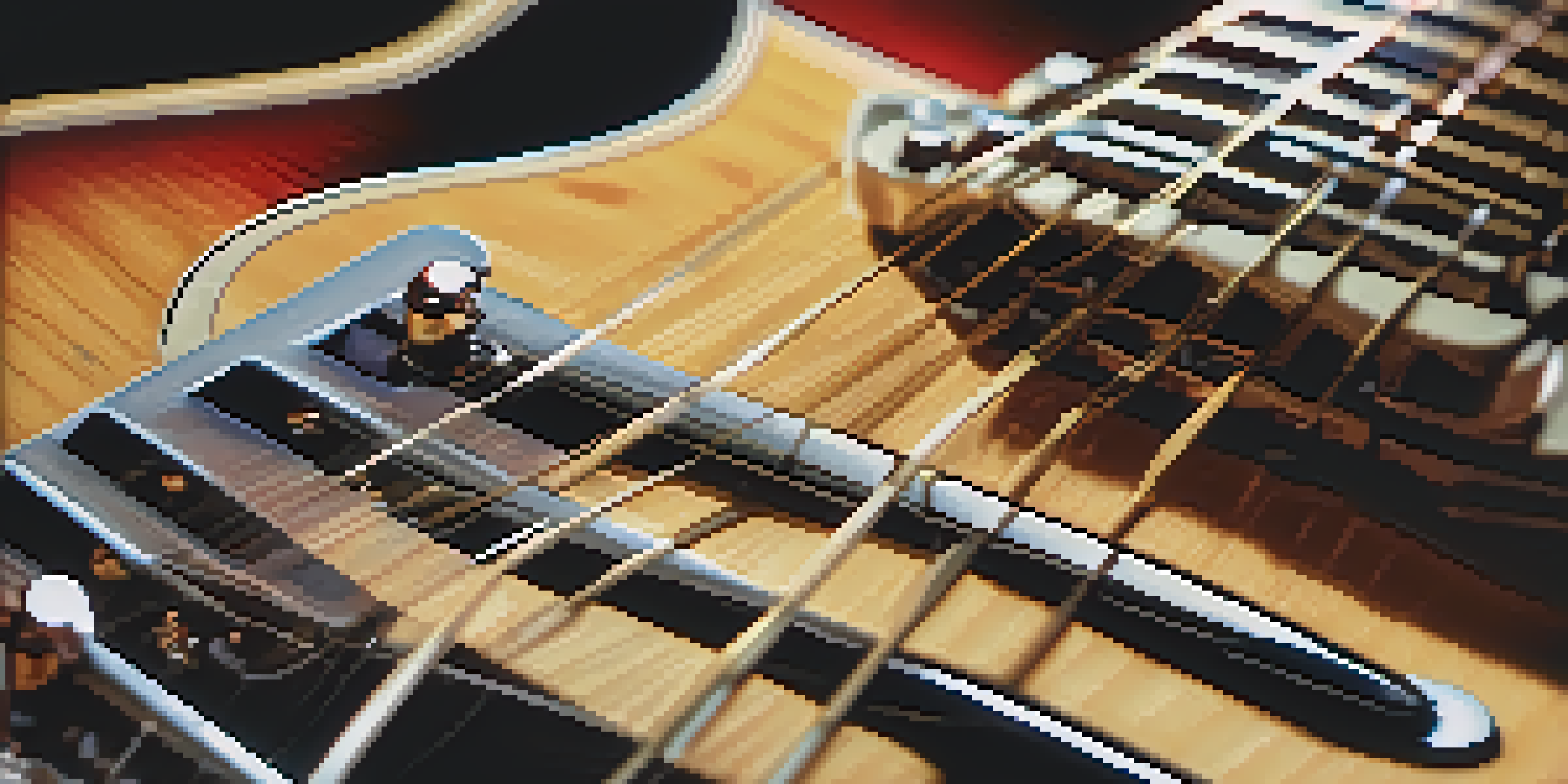Advanced Sliding Techniques for Professional Guitarists

Understanding the Basics of Sliding Techniques
Sliding techniques on the guitar can add a unique flavor to your playing. At its core, a slide involves moving your finger along the fretboard to create a smooth pitch transition. This technique can be used for both single notes and chords, making it a versatile tool for any guitarist.
The guitar is a miniature orchestra in itself.
To get started, it's essential to understand the mechanics behind sliding. Place your finger on a note and, with a firm but gentle pressure, slide it to another note without lifting the finger. The key is to maintain a consistent tone throughout the slide, which takes practice to master.
As you become comfortable with basic slides, you can experiment with different finger placements and slide lengths. This exploration will help you develop your own style, allowing you to express emotions and dynamics in your music.
Types of Slides: Straight and Curved
Not all slides are created equal, and understanding the two main types can enhance your technique. Straight slides involve moving directly from one note to another, while curved slides create a more fluid movement between notes. Both have their unique applications in different musical contexts.

For example, straight slides are great for transitioning between chords in a rock song. They provide a sharp, clear sound that can drive the music forward. On the other hand, curved slides can evoke a more emotional response, often used in blues or jazz to convey a sense of longing.
Master Sliding Techniques for Guitar
Sliding techniques add a unique flavor to your guitar playing and enhance expressiveness.
Practicing both types will allow you to choose the right slide for the mood of the piece you're playing. Take the time to incorporate these into your practice routine and listen closely to how each type affects your sound.
Finger Placement: The Key to Smooth Sliding
Proper finger placement is crucial for achieving smooth slides. The pressure you apply with your sliding finger can greatly affect the sound and clarity of the note. Ideally, you want to use the fleshy part of your finger, as it allows for better contact with the string.
You can’t be afraid to try new things, especially in music.
When sliding, try to keep your finger as parallel to the fretboard as possible. This technique minimizes friction and helps maintain a clean sound. Additionally, using your other fingers to support your hand position can enhance stability and control during slides.
As you practice, pay attention to how different placements feel and sound. Experimenting with finger angles and pressures will help you discover what works best for you, leading to more expressive playing.
Incorporating Slides into Your Playing Style
Once you've mastered the basic sliding techniques, it's time to integrate them into your playing style. This can be done by incorporating slides into riffs, solos, or even chord progressions. The goal is to use slides to enhance your musical phrases, making them more engaging.
For instance, try adding slides at the beginning or end of a phrase to create a sense of anticipation or resolution. This technique works particularly well in genres like rock, blues, and country, where emotional expression is key.
Types of Slides: Straight vs. Curved
Understanding the difference between straight and curved slides can enhance your musical expression.
As you develop your style, listen to your favorite guitarists and note how they use slides. By analyzing their techniques, you can find inspiration and ideas to incorporate into your own playing.
Combining Slides with Other Techniques
To truly elevate your guitar playing, consider combining slides with other techniques such as bends, hammer-ons, and pull-offs. This multifaceted approach creates a richer sound and allows for more complex musical phrases. The interplay between these techniques can lead to exciting musical ideas.
For example, you can slide into a note and then perform a bend to add even more expression. This combination can create a dynamic soundscape that captivates your audience. The key is to practice these techniques together, ensuring they flow seamlessly.
Don't be afraid to experiment with different combinations in your playing. As you become more comfortable with these techniques, you'll discover new ways to express your musical ideas.
Common Mistakes to Avoid When Sliding
Even experienced guitarists can fall into common pitfalls when using sliding techniques. One of the most frequent mistakes is lifting the finger too soon, which can result in a choppy sound instead of a smooth transition. It’s essential to practice maintaining contact with the string throughout the slide.
Another common issue is applying uneven pressure during a slide. This can lead to inconsistent tones, which detracts from the overall performance. Focus on keeping your finger pressure steady as you slide to ensure a clean sound.
Practice Tips for Smooth Slides
Consistent practice with slow, deliberate slides helps improve accuracy and overall technique.
To combat these mistakes, incorporate specific exercises into your practice routine. By dedicating time to focus on smooth slides, you'll develop muscle memory and improve your overall technique.
Practicing Slides: Tips for Improvement
Improving your sliding technique requires consistent practice and dedication. Start with slow, deliberate slides to ensure accuracy and clarity before increasing your speed. Gradually incorporating tempo will help you find the right balance between speed and precision.
Using a metronome can also be beneficial. Set it to a comfortable tempo and practice sliding to the beat, gradually increasing the speed as you become more confident. This approach will help you internalize the rhythm and timing of your slides.

Additionally, recording your practice sessions can provide valuable feedback. Listening back will allow you to identify areas for improvement and track your progress over time.